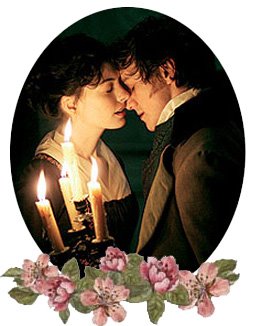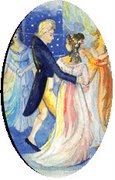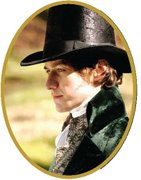Mansfield Park: Jane Austen’s tribute to Tom Lefroy Part 2
 Okay, Ladies and Gents, Mansfield Park review Part 2. I will try to keep it shorter than Part 1, but if not, you will forgive me, Fitzwilliam (think Colin Firth’s Darcy!). Special thanks to Michelle for her precious inputs on MP. This instalment picks up Chapters 4 to 11; bear with us, we sometimes go back and forth, picking up breadcrumbs we did not detect previously. But first, let me give another support for the theory that Jane Austen borrowed a lot from Tom Lefroy for her Fanny Price. Fanny lived in Portsmouth in
Okay, Ladies and Gents, Mansfield Park review Part 2. I will try to keep it shorter than Part 1, but if not, you will forgive me, Fitzwilliam (think Colin Firth’s Darcy!). Special thanks to Michelle for her precious inputs on MP. This instalment picks up Chapters 4 to 11; bear with us, we sometimes go back and forth, picking up breadcrumbs we did not detect previously. But first, let me give another support for the theory that Jane Austen borrowed a lot from Tom Lefroy for her Fanny Price. Fanny lived in Portsmouth in
On marriage
Chapter 4 finds us in the mind of Edmund as he observed the engagement of Maria Bertram with Mr. Rushworth.
Edmund was the only one of the family who could see a fault in the business; but no representation of his aunt's could induce him to find Mr. Rushworth a desirable companion. He could allow his sister to be the best judge of her own happiness, but he was not pleased that her happiness should centre in a large income...
It is obvious here that Edmund was not pleased that his sister should adopt the common practice of the greatest betrayal of self, as Michelle put it, giving yourself to someone you neither respect nor admire, denying yourself your true nature. To me, this was also Jane speaking… the way she advised her niece Fanny Knight in some letters. And it does not hurt to see that some names in
Then we arrive at Chapter 10, where Henry Crawford said to Maria Bertram:
'I believe I was relating to her [Julia] some ridiculous stories of an old Irish groom of my uncle's. Your sister loves to laugh...I could not have hoped to entertain you with Irish anecdotes during a ten miles' drive.' [Bolded words by Icha]
Cheeky Jane! To me, it's obvious that she was jesting about Tom Lefroy here. And Jane Austen often talked about marriage in Mansfield Park (well, also in her other novels), so we will return to the subject of marriage later on.
Black November
Chapter 11 particularly attracted me for the obvious second paragraph:
November was the black month fixed for his [Sir Thomas's] return...His business was so nearly concluded as to justify him in proposing to take his passage in the September packet, and he consequently looked forward with the hope of being with his beloved family again early in November.
Maria was more to be pitied than Julia, for to her the father brought a husband [Mr. Rushworth], and the return of the friend most solicitous for her happiness, would unite her to the lover, on whom she had chosen that happiness should depend...It would hardly be early in November, there were generally delays, a bad passage or something; that favouring something which every body who shuts their eyes while they look, or their understandings while they reason, feels the comfort of. It would probably be the middle of November at least; the middle of November was three months off. Three months comprised thirteen weeks. Much might happen in thirteen weeks. [bolded words by Icha, italics by JA]
The italic early and something invoked my suspicion. Didn't Tom Lefroy return to
Then a dialog between the sassy Mary Crawford and Edmund:
MC: ‘Your father's return will be a very interesting event.’
EB: ‘It will, indeed, after such an absence; an absence not only long, but including so many dangers.’
MC: ‘It will be the fore-runner also of other interesting events; your sister's marriage, and your taking orders.’
Before November 1798, Tom's last visit to
Edmund taking orders to become a clergyman. Can I translate 'taking orders' as taking one's responsibility? In the case of Tom Lefroy, Tom’s return to
Also, talking about Sir Thomas reminds me of Tom Bertram, who was (to us) the portrayal of Anthony Lefroy in Jane’s perspective. It occurred to me last night as I watched the 1999 DVD of Mansfield Park (what a great movie!) that TB might actually dislike his father so much, particularly on his inhuman treatments on his slaves (not to mention the slavery itself). Hence, Tom Bertram's drunk habit &c... in addition to he might be the kind of slack person, could also due to his aversion or major dislike towards his father for what he had been doing to the slaves? The Bertrams got dirty money anyway, why not wasting it? Hence Tom protested with being drunk and gambling, not unlike Anthony protesting Benjamin Langlois’ stern views of proper marriage by marrying an ‘undesirable’ woman.
Jane, Tom and star-gazing
In the last section of Chapter 11, we are introduced to another hobby shared between Edmund Bertram and Fanny Price, in addition to horse-riding.
EB: 'There's Arcturus looking very bright.'
FP: 'Yes, and the bear. I wish I could see Cassiopeia.'
EB: 'We must go out on the lawn for that. Should you be afraid?'
FP: 'Not in the least. It is a great while since we have had any star-gazing.'
Ah… l’amour… Such a romantic thing to observe the starry nights with your significant others…Now, my dearest friends, I don't know if you know that Tom Lefroy liked star-gazing, but click this old article of mine, and you will see that Tom was indeed interested in astronomy.
And I also wrote this in the article:
Now, of course then my imagination flew away to more than 50 years from that date, when the young dashing Tom Lefroy was still in Hampshire with Jane Austen, after a ball in Basingstoke or Manydown House (when he ran away as his family laughed at him about Jane…).
In one of those nights, it was possible that he took Jane outside to the balcony or the garden and pointed at the sky. Jane then said, ‘That’s a very bright star over there. Is that Venus?’ Tom smiled and answered, ‘No. That is not Venus; it’s Jupiter. Venus is –’ he directed Jane towards the other part of the dark night sky, ‘ – there! See that bright star there? Now, that’s Venus. And it is beautiful.’ He then looked back at Jane and, after a moment of silence, added, ‘But not as beautiful as you.’
Face/palm! Of course, the Jane/Tom scene there was merely my imagination, but I NEVER thought that small article will be useful now. If we link Fanny/Edmund and their star-gazing hobby with Jane and Tom, it is natural that I suspect that Tom Lefroy and Jane Austen indeed star-gazed together. At least, during Tom’s limited time in Hampshire. A great while ago.
Ahem. Now, let’s check the stars or constellations Jane, I mean, Fanny mentioned. Arcturus, the Bear and Cassiopeia. What about them? As a very amateur star-gazer, I am curious about the stars in MP, and had several sleuthing of them.
Arcturus/Bootes
According to Wikipedia, Arcturus is the brightest star in the Bootes constellation, only visible in Northern Hemisphere. The myth says that Arcturus is the bear guard who guards Ursa Minor and Ursa Major (Callisto and her son Arcas, seeded by Zeus), who protects and accompanies them for eternity. Arcturus is also the third brightest star in Earth's sky (after Sirius and
Now, let’s take a look at the constellation where Arcturus belongs (from the Earth’s viewpoint, that is). One of the earliest constellations identified by ancient humankind, Bootes is also known as the Herdsman. Herdsman, the Shepherd, like the Priest or a religious person. Reminds you of Tom Lefroy?
And again from Wikipedia: Boötes was also supposed to have invented the plough. This is said to have greatly pleased Ceres, the goddess of agriculture who asked Jupiter to give Boötes a permanent fixture in the heavens as a reward for doing this.
Big Dipper or Ursa Major (the stars Arcturus protects) is also called the Plough. Plough and agriculture, eh? Shall I remind you that Tom Lefroy loved gardening?
Bootes and Virgo
Bootes is located near several famous constellations, one of them is Virgo. In Poussin's painting (Shepherds of Arcadia) above, Bootes is the guy next to the maiden (Virgo). Together with Serpens and Hercules (squatting, tracing the inscription), they surrounded a tomb (Ophiuchus). An excellent example of hidden knowledge of astronomy by Nicolas Poussin in mid 17th century, for indeed you can see Bootes together with all these constellations (see Skymap.com for the month of August).
You can draw a straight line from Arcturus to Spica, the brightest star of Virgine/Virgo constellation. The old astronomy maxim is ‘follow the arc to Arcturus and speed on to Spica’. Virgo is, by the way, the zodiac of August, and also one of the only three female constellations in the Western astronomy (along with Cassiopeia and Andromeda).
Virgo the Celestial Virgin. Was Jane Austen not a virgin herself? ;-) Though we can also refer to Virgo as the representation of Mother Mary… As such, let’s see the meaning of Spica. Spica literally means ‘ear of wheat’, and hence was known since ancient times as the ‘Star of Prosperity’. Although I believe that Tom Lefroy truly loved Mary Paul later on, I do not doubt that there was prosperity motive, in the most respectable manner and intention of saving his family, in their marriage.
Virgo is also often called Astraea (‘starry’), as Wikipedia says:
According to one interpretation, the constellation depicts Astraea, the virgin daughter of the god Zeus and the goddess Themis. Astraea was known as the goddess of justice, and was identified as this constellation due to the presence of the scales of justice Libra nearby.
So, Virgo is also a representation of justice… who placed herself next to Bootes, the Shepherd. And was Tom Lefroy not a very pious barrister?
Anyway, Bootes and Virgo have always been closely linked. This is what Heavens Above says about the two constellations:
In Greek legend, Bootes is seen as representing Icarius, an Athenian who was taught the secret of winemaking by the god Dionysius. Icarius then allowed some peasants to sample his produce, but his kindness back-fired. The men became extremely drunk and were convinced that they had been poisoned, so they killed Icarius and buried him. His daughter Erigone and was so overcome with grief when she found his body that she hanged herself. Zeus transferred her to the heavens as Virgo, Icarius became Bootes, and Maera, the dog who had led Erigone to her father’s grave, became one of the dogs of Canes Venatici.
There is also a story of Bootes and Virgo as the symbol of Adam and Eve. Hmm… eating the apples, eh? Forbidden fruit of what? Of unfortunate marriage like Anthony Lefroy’s, or marriage for wealth, like Tom’s?

Anyway, let’s use the common knowledge that Virgo represents a virgin and see the graphic visualisation above. From these particular pictures, we can see that Bootes (the herdsman) seems to leave Virgo (the virgin). In the night sky, Bootes seems to face Cassiopeia (there is a picture down below; also see Skymap.com for August). And if we see the Virgo as Jane Austen herself, and Bootes as Tom Lefroy, who is Cassiopeia then?
Cassiopeia
In Greek Mythology, Cassiopeia was a beautiful but vain queen who insulted the Nereids, boasting that her daughter Andromeda was much prettier than the daughters of Poseidon himself (there…don’t let your mums do that, lest you will be chained and fed to the monsters!).
Cassiopeia forms a W or crown. If we translate it as 'noble lady', then Jane might be alluding to Mary Paul, who was a respectable woman, mostly for her wealth and connexion. Also, turn W upside down, and we have an M. For Mary! Or, we can see W as ‘wedding’ and M as ‘marriage’. There is a ‘Mary’ character in Pride & Prejudice that associates with ‘crown’ or ‘queen’. Mary King, a rich lass that almost married Wickham. Either way, to me, Cassiopeia refers to Mary Paul.
Let’s return to what Fanny said at the end of Chapter 11. Yes, and the bear. I wish I could see Cassiopeia. Could Jane be telling us that she wished to meet and understand Mary Paul better? And did Jane just mention ‘the bear’ or Ursa Major/Minor here for a decoy, or did she allude that she actually have met Anthony Lefroy, whom Tom protected, before? After all, Anthony lived in
My dear astronomer friend Alex (thanks a lot, Alex!) has kindly provided me with a simulation of the
In any case, Jane Austen evidently has designed the four lines of ‘mundane’ star-gazing talk in Chapter 11 very carefully, for the depth of information in the mere four lines of astronomy at the end of Chapter 11 is amazing. Let’s read Jane's letter
'Of my Talent in Drawing I have given specimens in my letters to You, & I have nothing to do, but to invent a few hard names for the Stars.'
Phew. After all this musings, I do not doubt that Tom Lefroy was a major trigger for Jane's interest in astronomy. Oh, and a spoiler for MP part 3 is found in Chapter 3, as Edmund said to Fanny:
“Why, indeed, Fanny, I should hope to be remembered at such a distance as the White house. You speak as if you were going two hundred miles off, instead of only across the park.”
Also see Elizabeth Inchbald. Thanks for reading the second part of MP review, and see you later!
Reference:
Faye, D. L. 1997, Jane Austen's Letters, Oxford University Press, Oxford.
Pic 1: Cover of
Pic 2: Henry and Mary Crawford, 1999
Pic 3: Mountains of Creation, interstellar clouds in Cassiopeia
Pic 4: Bootes, the Shepherd, from Acme
Pic 5: Virgo, the Virgin, from Acme
Pic 6: Simulation of night sky of
















































10 comments:
Icha,
Once again, although you may fairly be accused of overexuberance at times , you did indeed collect some very fine bread crumbs--I like the November one very much, and also about the Irish groom. You must however keep in mind that not everything Irish is also about Tom Lefroy--but you certainly made enough of a prima facie case to warrant continuing investigation! ;)
Icha my dear, I can't say I completely agree with your conclusions in this case, but I admire your zeal :)!
Ah then... Arnie and Tina, care to enlighten me more? Tina, I'm open to suggestions, of course, and I understand that it's mostly speculations here, but that's what I found so far :-D
Thanks again, friends!
Icha,
What I meant was, that your analysis of the November passage was very interesting, because it fit a pattern I have often found with JA's subtext, i.e., that text that is normally read one way CAN be read "offkilter" with a very different meaning. That is an example of informed creative speculation, which stays close to the text of the novel, and therefore moves in the direction of objectivity.
Whereas your analysis about mythology diverges very far from the text of the novel, and so it moves into the realm of creative fantasy sparked by the text, which is very personal and subjective. It's fun, and it's interesting, but it is extremely subjective.
As long as you recognize that these are qualitatively different forms of creativity, they both have value. But the second will not convince many other people that this was what JA intended.
Hmm... yeah, I somehow felt that you wouldn't agree with my star-gazing observation, Arnie... but that's okay. I think each of us has different view points, either slightly or major difference, hence I see the astronomy reference as something to relate to Jane and Tom, and you don't see it that way. I am quite well-versed and interested in astronomy, hence I picked the TL article about astronomy. By the same token, my fondness of mythology made my sensors filter the mythology-related breadcrumbs from Jane with considerable ease.
And of course, the Arcturus/Cassiopeia opinion will not convince many people, I understand the risk... because I accept the possibility of the mulberry tree (Pyramus/Thisbe mythos) in Sense & Sensibility as a reference to Tom and Jane.
Either way, I've been thinking of the Irish Groom. It can also refer to Anthony Lefroy (Tom's brother), though it might not be the case in the joke. But I don't ditch the possibility.
Thanks, though, for the opinions! Appreciate it!
But don't get me wrong, i am not saying that the astronomy and mythology angle is invalid, only that I think you're leaping to conclusions that are not justified. It could VERY well be that you are close to something that CAN be verified..so please don't let me discourage you, I hope you will be back in a couple of days with some corroborative evidence from the text of MP..... ;)
Absolutely--I can't wait to hear more.
Oh, no worries, Arnie. You're a detective, you would need more evidence than my habit of jumping into conclusions... But yeah, who knows one day it can be verified?
I'm helping Michelle with the 3rd part this weekend, hope to post it by Sunday.
Thanks!
Icha, you are a detective too! You gotta learn that killer instinct--when you catch the scent of a mystery, you have to want to be the one who solves it! ;)
Gosh, mate... I have no killer instinct yet... I still need to refrain myself from total desire of detective work, lest my real life will run downhill!
Sorry, MP part 3 not yet installed. Heh, it's NOT even yet re-arranged. But it will happen after Wednesday... I hope... real life things on the way here...
Post a Comment